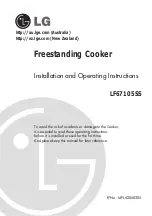
8
Preparing vegetables
Always chop fibrous vegetables, ie carrots, turnips, swede, potato etc, into small
dice or thin slices before cooking. This is because vegetable fibres are actually
harder to break down than animal fibres when cooked at low temperatures.
Whole potatoes are best if cooked on the HIGH setting. Frozen vegetables must
be thawed before adding to other foods cooking in the Slow Cooker, for example
when adding to a casserole.
When cooking vegetables and meat together in the Slow Cooker, the vegetables
tend to cook at a slower rate than the meat. To gain the best results, position the
vegetables on the base and sides of the Slow Cooker and place the meat on top.
Dried beans and pulses
Overnight soaking of dried beans and pulses is required. After soaking, drain and
place in the Slow Cooker and cover with sufficient water to reach double their
volume. Cook beans or pulses on the HIGH setting for 2-4 hours or until tender.
Pre-soaked beans and pulses will cook a little faster. If tinned beans are to be
used, add these 30-45 minutes before the end of the cooking time.
General guidelines
• Always ensure that boiling liquid is used.
• Always wear oven gloves when handling the Slow Cooker during use.
• Rice, noodles and pasta are not recommended for long cooking times (except
pudding rice). Cook them separately and then add during the last 30 minutes.
• The Slow Cooker should be pre-heated for at least 15 minutes before adding
the ingredients.
• Use the best quality stocks you can buy. A good stock forms the base of a dish
and can transform the flavours from being merely average to excellent.
• Never place frozen meat or poultry in the Slow Cooker. It must always be
defrosted before use.
• Do not fill the cooker to the brim with food.
• Always ensure the food is thoroughly cooked before eating. If adding fresh
milk or yoghurt, this should be done during the last 2 hours. Evaporated milk
may be added at the start of cooking.
Slow cooker instructions









































